But instead of disengaging and dispersing, both sides scrambled to re-assert their respective idea of where the unmarked Line of Actual Control (LAC) ran through the valley. This led to physical clashes and casualties on both sides as they avoided using firearms to honour bilateral confidence-building agreements.
‘Peace and tranquillity’ along the LAC — a foundational consensus reached between Chinese President Xi Jinping and Indian Prime Minister Narendra Modi — lay trampled. It was a strange way for Asia’s civilisational neighbours to test each other’s willingness to create a new world after COVID-19. If that was not their intention, they certainly botched a strategic showdown over local geopolitics.
Throughout the confrontation, China and India sought to reinforce their territorial claims in Ladakh, which was already under new strategic light. On 31 October 2019, India assumed full federal control over Ladakh by carving it out as a union territory. Until then, it was a part of an autonomous Indian State (province) of Jammu and Kashmir (ISJK).
Delhi’s previously ‘loose’ federal control over ISJK allowed Beijing to think of settling its territorial claims in the region over time. But with India reasserting its sovereign rights over Ladakh, China has lost this luxury of biding time. In India’s view, Ladakh includes Aksai Chin, which China continues to administer as its own sovereign domain. Significantly, the latest Sino-Indian face-off occurred at a few places bordering Aksai Chin.
Historical claims and global ambitions apart, India’s recent construction of a major strategic road and modern military airstrip close to Chinese-claimed territory alerted Beijing to a new reality. With superior economic resources and higher defence expenditure, China had previously fortified its side of the LAC with robust military infrastructure. To sustain this dominance, China began taking countermeasures. In a chain-reaction, as India responded, clashes began.
There is more to such local geopolitics than the changing balance in military infrastructure on either side of the LAC. Relevant, too, is the local geostrategic configuration of Siachen Glacier, Shaksgam Valley, Daulat Beg Oldi (DBO) and Karakorum (KK) Pass. While India dominates in Siachen, China controls Shaksgam. DBO and KK Pass are critical to any future Sino-Indian agreement in respect of Ladakh.
Will China seek to internationalise the latest confrontation? Possibly. The China-Pakistan Economic Corridor, further west in the erstwhile princely state of Jammu and Kashmir, has raised the stakes for Beijing in the entire region. Senior Chinese diplomatic sources have said that ‘good options’ for peace and tranquillity along the disputed Sino-Indian border in Ladakh could still be considered.
This appears to reflect a practical stance as Beijing evaluates Delhi’s willingness and ability to change the current world order. India supports the United States in its apparent ambition for a post-COVID-19 global governance system. This is partly a result of the drift in China–India engagement, despite their ‘informal’ in-camera dialogue at the highest political level, first instituted in 2018 following their military face-off at Doklam in 2017.
Some analysts see a parallel between the non-lethal Doklam crisis and the latest clashes in Ladakh in terms of the resoluteness of both countries. By 30 June 2020, China and India held intermittent talks at the diplomatic and military levels to stabilise the Ladakh situation. Overarching all these strands are growing signs that China is bracing for a decisively dominant role in a possible post-COVID-19 world order.
The United States, too, has co-opted India — among a few other players like Japan, Australia and Vietnam — to fight the pandemic in the Indo-Pacific arc. China is already on a humanitarian offensive against COVID-19 across the world.
India has disclosed that the US-led informal coalition harbours a deeper strategic plan, too. According to Delhi, Washington and its partners ‘have underlined the need for a new template of globalisation and for international institutions to reflect contemporary realities’. Delhi’s message to Beijing is that a potential coalition of the willing, including the United States and India, is taking shape to reorder the post-COVID-19 world.
India may, therefore, see itself as a potential ‘swing-state’ in a Sino-US tussle for post-COVID-19 global dispensation. Beijing’s agenda has long been set — an international ‘community with a shared future’, founded on ‘win-win cooperation’ in a ‘new era’ of Chinese ‘national rejuvenation’. Decoded, this means a system led by a prosperous China in a community of friendly partners.
China’s ambition for a potential leadership role is clear as daylight. But despite the unknown outcome of the US presidential election later this year, Delhi has backed the United States to bring about a ‘new template of globalisation’ — code for globalisation without Chinese characteristics. For both China and India, this competition may be as challenging as their boundary dispute.
PS Suryanarayana was until 30 June 2020 a visiting senior fellow at the S Rajaratnam School of International Studies (RSIS), Nanyang Technological University (NTU), Singapore. He is author of Smart Diplomacy: Exploring China-India Synergy (World Century, 2016) and The Elusive Tipping Point: China-India Ties for a New Order (forthcoming).
All views expressed personal.

